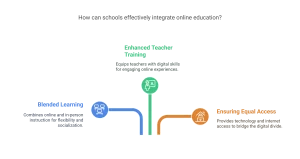The Role of Online Education in Modern Classrooms
In the digital age, education has evolved far beyond the traditional classroom setting. Online education has emerged as a game-changer, especially for schools, offering students, parents, and educators a wealth of opportunities for growth and development. While online education may not replace in-person learning entirely, it plays a crucial role in shaping the future of schooling.
Understanding Online Education In Schools
Online education refers to learning that takes place over the internet, either in a fully virtual environment or through a blended approach that combines digital learning with face-to-face interaction. It encompasses a wide range of tools and platforms, from live classes to pre-recorded lessons, interactive assessments, and digital resources.
This new form of education can benefit students of all ages and educational levels, offering a flexible, personalized, and often more accessible approach to learning. It has gained significant traction in recent years, especially during the pandemic, and continues to evolve.
Key Benefits Of Online Education In Schools
1. Accessibility And Convenience
One of the most significant advantages of online education in school is its ability to break down geographical barriers. Students can access learning materials and attend classes from any location with an internet connection. This is particularly beneficial for students in remote or underserved areas where access to quality education might be limited.
- No commute: Students can attend classes from the comfort of their homes, saving time and energy, which will result in more productivity.
- Learning on the go: With mobile-friendly platforms, education becomes accessible even while traveling or during free time.
2. Flexibility In Learning
Online education offers an unmatched level of flexibility, allowing students to learn at their own pace and convenience. This self-paced learning model helps cater to different learning styles and speeds, making it easier for students to master subjects without feeling rushed.
- Unsynchronized learning: Students can access recorded lessons and complete assignments on their schedule.
- Time management skills: Students learn to organize their learning time effectively, a skill that will be beneficial in their future careers.
3. Personalized Learning Experience
Unlike traditional classroom settings, online education can offer a highly personalized learning experience. Platforms often use advanced algorithms to tailor lessons and assignments to a student’s unique strengths, weaknesses, and learning preferences.
- Adaptive learning tools: These tools adjust the difficulty level of tasks based on a student’s performance.
- Targeted interventions: Teachers can provide targeted support to students who are struggling with specific concepts.

Challenges Of Online Education In Schools
Despite its many benefits, online education does come with certain challenges that need to be addressed for it to be truly effective.
1. Digital Divide
Not all students have equal access to the internet and digital devices. The gap in access to technology is still a big problem, especially for people in poor or rural areas.
- Device access: Some students may not have the necessary technology, such as laptops or tablets, to engage with online lessons.
- Internet connectivity: Poor internet connections can create interruptions in learning, making it difficult to follow along with live lessons or access resources.
2. Reduced Social Interaction
Online education, while convenient, can limit face-to-face interactions between students and teachers, as well as among students themselves. The lack of social engagement can impact the development of essential social skills like communication, teamwork, and conflict resolution.
- Limited peer interaction: Students miss out on group activities, collaborative projects, and spontaneous conversations that happen in a physical classroom.
- Isolation: The lack of physical presence may lead to feelings of loneliness or disengagement among some students.
3. Self-Discipline And Motivation
Without the structure of a traditional classroom, students need to be self-motivated and disciplined to stay on track. While some students thrive in this environment, others may struggle to maintain focus and complete assignments on time.
- Time management issues: Without strict schedules, students may procrastinate or miss deadlines.
- Decreased accountability: The absence of direct supervision can lead to a lack of responsibility for their learning.

How Schools Can Integrate Online Education Effectively
To maximize the benefits of online education while addressing its challenges, schools can implement a few strategies:
1. Blended Learning Approach
One way to make online education more effective is through a blended learning model that combines both online and in-person instruction. This model offers the flexibility of online learning while maintaining the benefits of classroom interaction and socialization.
- Flipped classrooms: Teachers can assign online lessons for students to review at home, and then use classroom time for discussions, activities, and assessments.
- Collaborative projects: In-person group work can complement online learning, fostering peer-to-peer engagement and teamwork.
2. Enhanced Teacher Training
Teachers need to be adequately trained in using digital tools and platforms effectively. By providing educators with proper training and resources, schools can ensure that they can create engaging and effective online learning experiences for their students.
- Tech skills: Teachers should be well-versed in using educational technology to facilitate learning.
- Engagement strategies: Online teaching requires different methods to keep students engaged, such as interactive quizzes, live discussions, and multimedia content.
3. Ensuring Equal Access
To bridge the digital divide, schools should work towards ensuring that all students have access to the necessary technology and internet connection. This can be done through initiatives like providing low-cost devices, offering subsidized internet plans, or creating community hubs where students can access learning resources.
- Device loans: Schools can offer devices for loan to students who cannot afford them.
- Community support: Schools can partner with local organizations to help provide internet access to underserved students.
The Future Of Online Education In Schools
As technology continues to advance, online education will likely play an even more significant role in the future of schooling. Virtual reality, artificial intelligence, and other cutting-edge technologies have the potential to create even more immersive and personalized learning experiences. However, for online education to reach its full potential, it will require careful integration with traditional educational systems, ensuring that the focus remains on the holistic development of students.
We cannot deny the fact that the role of online education in schools is significant, offering flexibility, accessibility, and personalized learning experiences. However, to ensure its effectiveness, schools must address challenges like the digital divide and the need for enhanced teacher training. By integrating online learning with traditional methods, schools can create a balanced and inclusive educational environment for all students.
This blog structure, with clear headings and bullet points, ensures that readers can easily navigate and understand the critical aspects of online education in schools.

